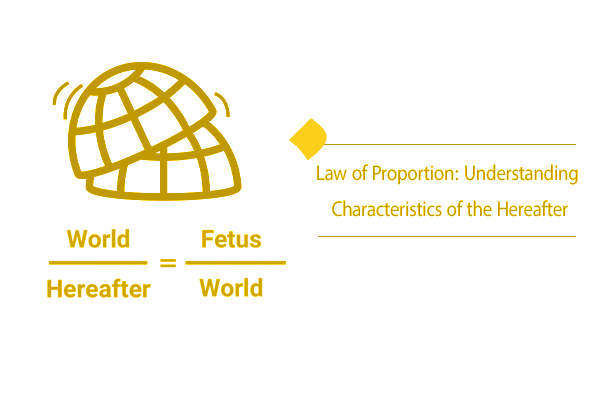The Relationship between the Mother’s Womb, This World, and the Hereafter Follows the Law of Proportion
Usually, the first thing that comes to our mind when we hear ratio or proportion is mathematics because proportion is one of the most basic concepts that we have dealt with in mathematics. A ratio is a formula by which we compare two quantities. Even if we are not mathematically literate, this concept is so familiar to us that we recognize it easily. For example, if at a party someone puts two pieces of pizza on everyone’s plate, but three pieces on our plate; or if someone tells a farmer that the right to water is two hours for everyone, but one hour for him; or if a person has three eyes on his face instead of two eyes, we react because the Law of Proportion has not been observed.
The Law of Proportion also exists on larger scales, and as soon as it breaks down, we usually go through a crisis. For example, if the number of people living in a place is not proportional to its facilities, or if the amount of rain is not proportional to the capacity of the soil, the balance is disturbed and may even cause a disaster. So the Law of Proportion applies everywhere in our lives, from natural things to matters that we face in our personal life. By observing proportion, we reach equilibrium and balance, and by juxtaposing relationships that have equal proportions, we find answers to many difficult questions that are beyond our ability to understand. In fact, finding many astronomical distances or values is possible only by establishing a proportional relationship. The scope of the Law of Proportion is such that it covers even the stages of life so that there is a close relationship and proportion between the different stages of our life. For example, the ratio of our life in the fetal stage to our life in this world is like the ratio of our life in the hereafter to our life in this world.

In this article, we are going to examine this ratio extracted from a prophetic narration and extract the rules hidden in it, but for a better understanding of this ratio, there are prerequisites, one of which is knowing the concept of the womb.
The Meaning of the Womb
All of us, without exception, have lived in our mother’s womb for a certain period before birth. Although we do not remember anything from that time, today, thanks to the advancement of science and technology, we are somewhat aware of what happens to the fetus inside the mother’s womb.
What differentiates the womb from its surrounding environment is the constructive power of the womb. The mother’s womb has the ability to make a complete person or creature from a single cell in nine months. If we ignore the constructive capability of the womb, it is considered a part of the world like other parts of the mother’s body. As a result, the womb is more than an organ and is also used as a concept. It can be stated that the womb means any environment that has the ability to construct and is not limited to an organ of the mother’s body. Just as the mother’s womb can transform a cell into a complete human being within nine months, other wombs also have the constructive power according to their status. So the main quality of the mother’s womb is the ability to build the body.
In this world, apart from the mother’s womb, there are other wombs, all of which share the common characteristic of being more constructive and effective than the surrounding environment. Although the mother’s womb is a part of the world, it is the only environment that has the ability to build a body. In nine months, the womb builds a body whose damaged organs cannot be repaired by the world, or repairing them may be quite challenging.
Characteristics of Fetal Life in the Mother’s Womb
When we talk about the equality of two proportions, we mean that the relationship between two phenomena is equal to two other phenomena on a different scale. For example, when we say that the proportion of the size of our house to the city in which it is located is like the proportion of the size of our city to the Earth, we are actually establishing a relationship between these sizes in order to understand the intangible scale of this proportion through a more tangible scale. For example, to understand the size of the city to the Earth, we use the proportion of the size of the house to the city.
Knowing the concept of the womb and gaining a general understanding of the Law of Proportion, we want to examine the relationship between the mother’s womb and the world, and the world and the hereafter. As a fetus, we spend a short time in the mother’s womb. After birth, we do not even consider the fetal period as a part of our lives. In this short time, we are constantly making tools and preparing ourselves to live in the world we are going to be born into. While we are in the mother’s womb, we are also in the world. A world that we have never seen before and we have no understanding of its magnitude, diversity, and beauty. The greatness of the mountains, the beauty of flowers and fish, and the brilliance of the stars in the sky have no meaning for us as a fetus in the mother’s womb because we have no previous understanding or experience of them. We have only understood the tight, dark, and small environment of the mother’s womb, and because of our attachment to it, we do not want to leave it. In the mother’s womb, we are making hands, feet, eyes, and brain, which we do not need during our embryonic period, and as soon as we are born into the world, the importance of each of these tools becomes clear to us.
The smallest disruption or failure to fulfill our duties in the mother’s womb can bring us years of torment and discomfort in the world. Although in the mother’s womb, we are unaware of the importance of what we do, but our only goal as a fetus is to have a healthy and strong birth into the world. According to the Law of Proportion, the world is a womb for the hereafter, and the relation between the world and the hereafter follows the characteristics of the relation between the womb and the world. We will discuss these features in detail in future lessons.
In this article, we talked about the Law of Proportion. We stated that the relation between the mother’s womb and the world is like the relation between the world and the hereafter. In order to better understand this relation, we explained the concept of the womb, and in the end, we also described the conditions of the fetus in the mother’s womb.
If you want to know about knowing these characteristics and the womb-like relation of this world to the hereafter, read “The Womb-Like Power of the World.”
Has understanding the Law of Proportion helped you better understand the relation between the womb and the world? Please share your thoughts with us.

